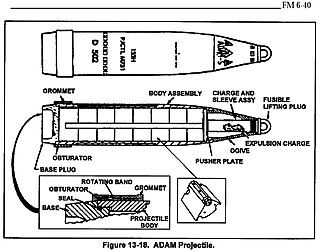
The Mitsubishi Ki-67Hiryū was a twin-engine medium bomber produced by Mitsubishi and used by the Imperial Japanese Army Air Force and Imperial Japanese Navy Air Service in World War II. Its Army long designation was "Army Type 4 Heavy Bomber" (四式重爆撃機). Its Navy designations were "P2M" and "Q2M".

The 3.7 cm Flak 18/36/37/43 was a series of anti-aircraft cannon produced by Nazi Germany that saw widespread service in the Second World War. The cannon was fully automatic and effective against aircraft flying at altitudes up to 4,200 m. The cannon was produced in both towed and self-propelled versions. Having a flexible doctrine, the Germans used their anti-aircraft pieces in ground support roles as well; 37 mm caliber guns were no exception to that. With Germany's defeat, production ceased and, overall, 37 mm caliber anti-aircraft cannon fell into gradual disuse, being replaced by the Bofors 40 mm gun and later, by 35-mm anti-aircraft pieces produced in Switzerland.

The Tellermine 43 was a German circular steel cased anti-tank blast mine used during the Second World War. It was a simplified version of the Tellermine 42, which enabled simpler production techniques. Between March 1943 and the end of World War II, over 3.6 million Tellermine 43s were produced by Germany. Copies of the mine were produced by several countries including Denmark (M/47), France and Yugoslavia (TMM-1).

Area Denial Artillery Munition (ADAM) is a family of United States land mines and 155 mm artillery projectiles.

The National Development Complex (NDC) is a Pakistani defence and aerospace contractor and a division under the National Engineering and Scientific Commission (NESCOM). Founded in 1990 at the MoD, the NDC engaged in research and development in space-based missile systems and expanded its services towards developing the land-based weapons systems for the army as well as naval systems for the navy.

The AT2 mine is a scatterable anti-tank mine developed by Dynamit Nobel. It can be scattered from artillery rockets or from mine laying systems, and was used by the British, German and Norwegian armed forces until the signing of the Ottawa Treaty.
The TMD-44 and TMD-B are simple rectangular Russian wooden box cased anti-tank blast mines, they were both used during the Second World War. Both mines are similar in design, differing only in fuzing mechanism. The wooden construction of both the mines makes them unpredictable as rot and insects can eat away the wooden case, reducing activation pressure to as little as 3 kg. Both mines are found in a number of countries including Afghanistan, Angola, Chad, Cuba, Egypt, Korea, Mozambique, Namibia, Rwanda, Yemen, Zambia, and Zimbabwe.
The Model 52 mine is a Swedish circular plywood cased anti-tank blast mine. It is in service with the Swedish army. The mine can be fitted with a number of different fuzes and pressure plates including a three pronged plate and a pentagonal pressure spider and a tilt-rod fuze.
The Model 41-47, Model 47, and Model 47-52 are circular Swedish anti-tank blast mines. The mines are broadly similar, differing only in size and weight.
The MI AC PR are a series of French minimum metal blast resistant mine anti-tank blast mines. The mines can be laid by hand or automatically from the Matenin mine laying system at a rate of gdnbekbd500 per hour. The mines use a clockwork arming delay, which can also self neutralize the mine after a set period. They have a secondary fuze well in the base that allows anti-handling devices to be fitted.
The Model 49 is a large cylindrical Swiss anti-personnel stake mine. The mine is no longer in service with Swiss forces and all operational stocks of the mine have been destroyed. The mine is normally stake mounted, and uses the ZDZ-39 fuze, which can be operated by either pull or tension release. The mine has a concrete fragmentation jacket with embedded steel fragments.
The PM-43 and PM-68 are Finnish anti-personnel fragmentation mines.

The 7.5 cm KwK 40(7.5 cm Kampfwagenkanone 40) was a German 75 mm Second World War era vehicle-mounted gun, used as the primary armament of the German Panzer IV (F2 models onwards) medium tank and the Sturmgeschütz III and Sturmgeschütz IV assault guns (F models onwards).
The Model 123 is a small Thai Claymore style directional anti-personnel mine. The mine has a square plastic main body with a convex front face marked with a triangle which is supported by two sets of scissor legs. Inside the main body is a layer of four hundred 5.5 millimeter steel ball bearings embedded in an RDX type explosive. The mine is normally used with an electrical detonator which is inserted into the top of the mine.

The Hafthohlladung, also known as the "Panzerknacker" was a magnetically-adhered, shaped charge anti-tank grenade used by German forces in World War II, sometimes described as a mine.

The RG-34 is a South African MRAP. Specially designed to be mine-resistant, it has been produced in multiple variants, equipped for troop or cargo transport, command, and fire support. Originally showcased with a wide turret ring and a 90mm rifled cannon, the RG-34 was one of the first MRAPs configured to carry a large gun system.

The Mahindra Mine Protected Vehicle-I (MPV-I), is an Indian MRAP-type armored personnel carrier manufactured by Defense Land Systems, a joint-venture of Mahindra & Mahindra Limited and BAE Systems, the first vehicle made under the venture. It is an improved Casspir variant built under licence.












